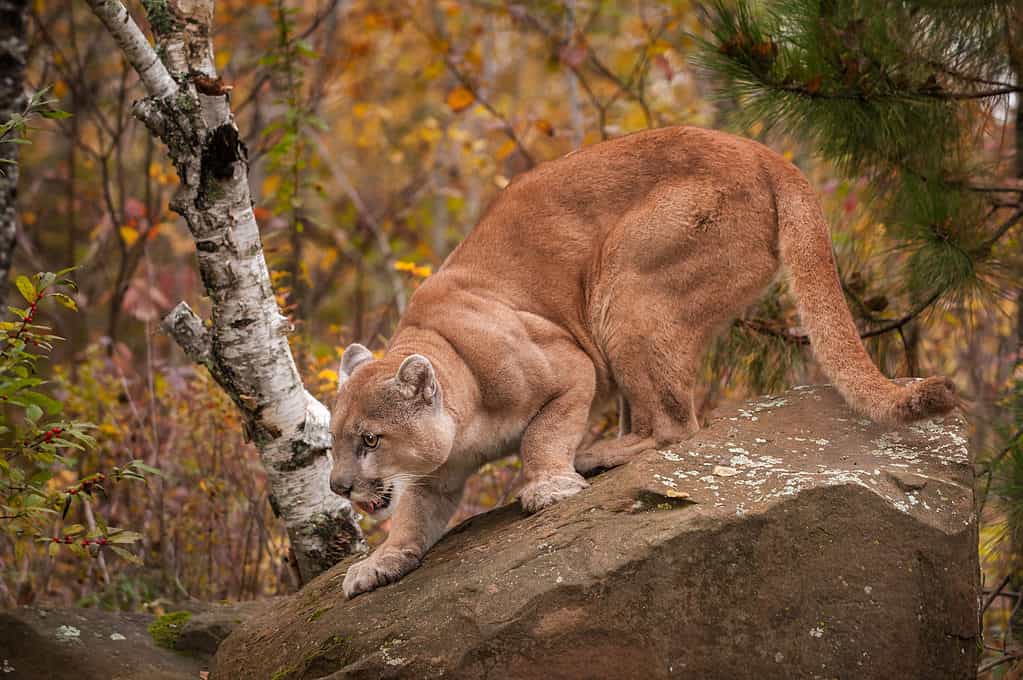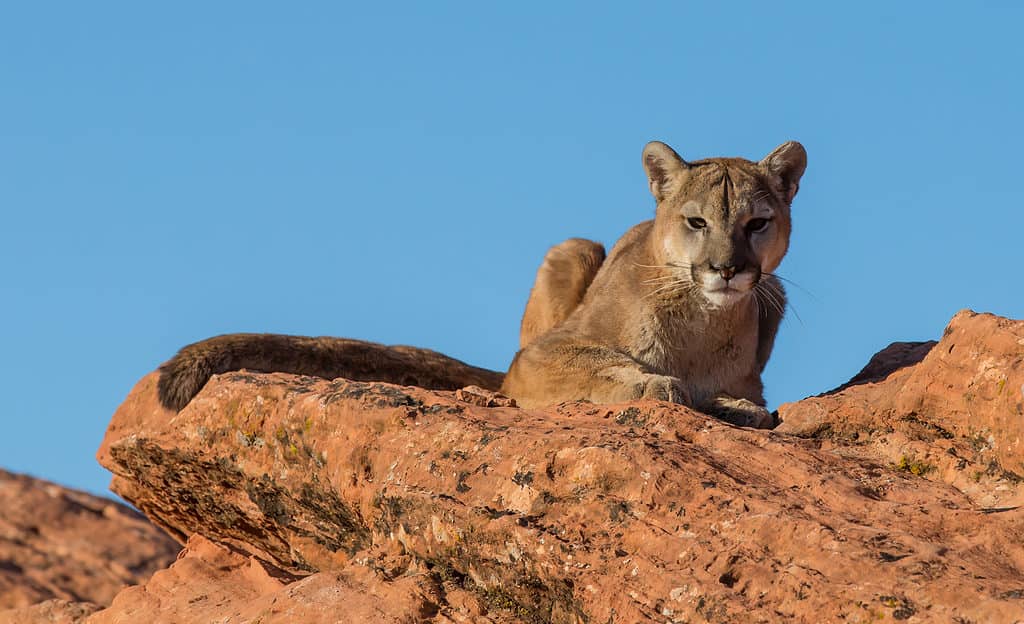Are you ready for an animal battle? This animal matchup compares two strong forest-dwelling mammals: a mountain lion vs. wild boar.
Mountain lions have the widest geographic range of any land mammal throughout the Western Hemisphere. They spend their time roaming the land, looking for the perfect opportunity to pounce on prey.
Feral hogs have more of an aggressive attitude, charging toward threats tusk first. These dangerous pigs have a great sense of smell, so the hog will know the mountain lion is coming long before the fight begins. But will it be ready for what the big cat brings to the ring?
Follow along as we play out one of the most intense animal battles yet, a mountain lion vs. wild boar. Who will be the champion? Let’s find out.
Mountain Lion vs. Wild Boar

Mountain lions spend their time roaming the land, looking for the perfect opportunity to pounce on prey.
©Holly Kuchera/Shutterstock.com
| Battle Factors | Mountain Lion | Wild Boar |
|---|---|---|
| Physical Stats | 6 feet long 140 pounds 50 mph | 6 feet long 3 feet tall 400 pounds 30 mph |
| Attack Abilities | 2-inch-long canines 2-inch-long claws Bite force 400 PSI Jumps 18 feet vertically Leaps 40 feet horizontally | 42 to 44 teeth Charges threats Sharp tusks Slashes Gores |
| Defenses | Climbs trees Camouflage coat | Thick skin Aggressive attitude |
By the end of the battle, we’ll have covered each competitor’s physical stats, attack abilities, and defenses. We’ll be fighting for three rounds to ensure this is a fair animal matchup. Each round will compare the advantages each species brings to the table.
For instance, wild boars have sharp tusks they use to slash attackers. They can slash open a stomach with a single swipe! And mountain lions know how to use their powerful claws to swat away threats, clawing their way to victory. These attack abilities help each species in everyday life, but how will they match up against each other?

Wild boars have sharp tusks they use to slash attackers. They can slash open a stomach with a single swipe!
©iStock.com/JMrocek
Round 1: Physical Stats
Round one is one of the most important rounds of this animal battle!
Wild boars can grow up to 6 feet long and have a shoulder height of 3 to 5 feet. They weigh between 150 and 220 pounds but can grow much larger depending on food availability. There are reports of some wild boars growing to be as large as 400 pounds.
An average mountain lion is around 6 feet long and weighs 136 pounds. But they can grow much larger, too. The record for a mountain lion’s weight stands at 276 pounds. Since both competitors are big, it’ll be their agility that helps them gain an advantage.
Who do you think is faster? The mountain lion or the wild boar? If you guessed mountain lion, you’re right! This wildcat can run almost 20 mph faster than a wild boar.
Mountain lions can comfortably run at 10 miles per hour across long distances. When they’re chasing prey, they’ll pick up their speed to around 30 mph. As they begin closing in, they can go even faster! Mountain lions top out at an impressive rate of 50 mph.
Wild boars are also dangerously fast and could outrun a human within seconds. Despite their stout bodies, they’re surprisingly agile as they race across the ground at 30 mph.
Round 2: Attack Abilities
The animal rumble continues with round two!
Mountain lions are known for being stealthy predators. And wild boars are known for having a nasty attitude. Which species will be aggressive enough to win this round? Let’s start by looking at the wild boars’ advantages.
The wild boar has long lower canines that protrude from the lower mandible, making up their tusks. These tusks grow throughout their lifetime and are perfect for slashing open stomachs. They also have 44 diphyodont teeth, which means they develop two sets of teeth throughout their life, similar to humans. And their teeth are much larger than those of domesticated pigs.
Using their muscular bodies, wild boars charge their prey at 30 mph. They have a rhino-like ferocity. The fast attack allows them to drive their tusks deep into the victim’s flesh. These opportunistic hunters target large pigs, dear, snakes, and monkeys.
Mountain lions are carnivores; they’re on a strict meat diet. These stealthy cats know how to stalk prey with expert precision. They hide in the brush of the forest or high up in a tree. When it’s time to pounce, a mountain lion can cover 40 feet in a single leap! Then it can drive its 2-inch-long claws into the prey’s body, grabbing so tightly the animal cannot escape. One of the mountain lion’s signature moves is its lethal bite. Using a bite force of 400 PSI, it can sever a spinal cord in a single chomp.
Round 3: Defenses
The last round of our animal battle determines the winner (and the loser). How do they evade threats? And how does each species respond when face-to-face with an attacker? Let’s find out!
Mountain lions do a great job of evading threats altogether. These elusive wildcats know how to roam through the forest without drawing attention to themselves. Nature gives them a helping hand by providing them with two different camouflaging fur coats throughout their life. As cubs, mountain lions have spots to help them blend in. Fully grown adults have a reddish or gray color coat for camouflage.
If something scares the mountain lion, it can quickly climb a tree with its retractable claws. It can also jump to safety. A mountain lion’s long hind legs help it jump 18 feet in one leap. These cats can also move horizontally, covering 40 feet in a single pounce. And if the mountain lion can’t evade a threat, it’ll face it head-on using its strength, claws, and sharp teeth.
There are two different approaches wild boars have in response to a threat. They either run away quickly or charge head-on at 30 mph. Their behavior is erratic and unpredictable, making it difficult for the mountain lion to determine what move to make next.
Another defensive advantage the wild boar has is its thick skin. Even if the mountain lion tries slashing the pig with its claws, the cat will have to hit the perfect spot to deliver a fatal blow.
Our competitors are tough, tenacious animals, but only one can be the winner of this animal matchup. It’s time to find out who is taking home the championship!
Who Is the Champion?

When you add in the mountain lions’ sharp claws, deadly teeth, and powerful bite force, it’s clear why they deserve the championship title.
©Warren Metcalf/Shutterstock.com
Who is the winner of this mountain lion vs. wild boar matchup? The mountain lion! These wildcats are much more agile than wild boars. With the ability to leap 40 feet across the ground, and jump 18 feet in the air, they have an instant advantage over the wild boar. When you add in the mountain lions’ sharp claws, deadly teeth, and powerful bite force, it’s clear why they deserve the championship title.
That’s not to say that the wild boar wouldn’t put up a fantastic fight, though. Wild boars have sharp tusks to slash open prey’s stomachs, with some victims as large as deer! But taking down a docile deer is much different than winning against a mighty mountain lion.
The only way the wild boar could gain the advantage is if the mountain lion was sick, injured, or young. Then it might be able to catch the big cat by surprise and charge the kitty at full speed, tusks first. Unfortunately for the wild boar, the mountain lion in this animal matchup was a healthy full-grown adult. Once the mountain lion bit down on the boar, it was game over.
The photo featured at the top of this post is ©
Thank you for reading! Have some feedback for us? Contact the AZ Animals editorial team.







